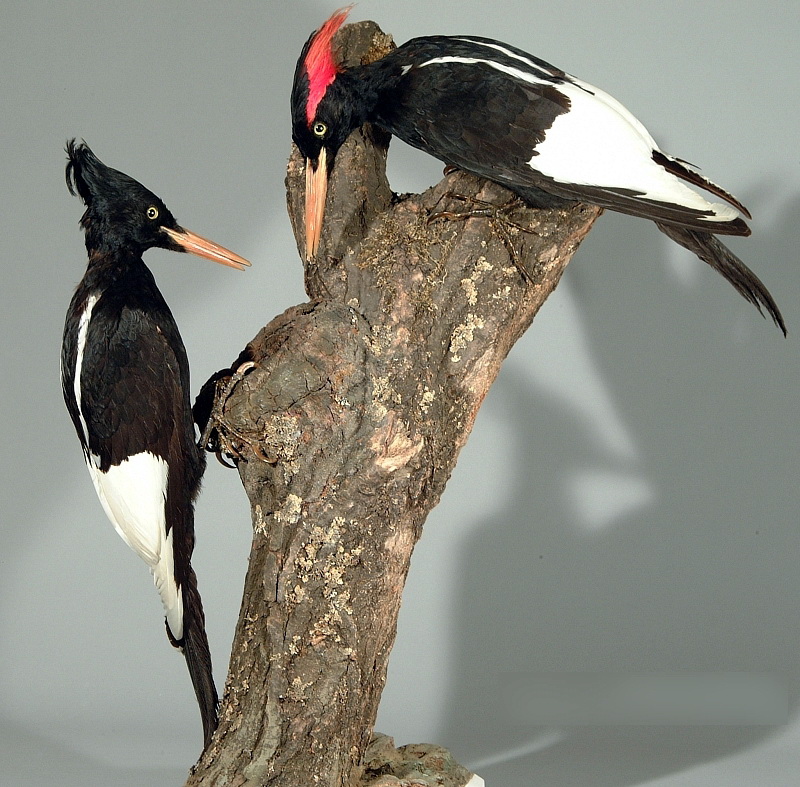Imperial Woodpecker (Campephilus imperialis) - Wiki Imperial Woodpecker
From Wikipedia, the free encyclopedia
[Photo] Kaiserspecht, (Campephilus imperialis), male and female from Mexico, Museum Wiesbaden, MWNH, Naturhistorische Landessammlung. Date 2003. Author Fritz Geller-Grimm
The Imperial Woodpecker (Campephilus imperialis) is a member of the woodpecker family Picidae. Due to its close relationship and similarity to the Ivory-billed Woodpecker, it is sometimes also called "Mexican Ivorybill" but this name is also used for the Pale-billed Woodpecker. If it is not extinct, it is the world's largest woodpecker species. The large (60 cm/23 in) and conspicuous bird has for long been known to the native inhabitants of Mexico and was called cuauhtotomomi in Nahuatl, uagam by the Tepehu??n, and cumec??cari by the Tarahumara.
The male had a red-sided crest, but was otherwise black, apart from the inner primaries, which were white-tipped, white secondaries, and a white scapular stripe which unlike in the Ivory-billed Woodpecker did not extend on the neck. The female was similar but the crest was all black. It was once widespread and, until the early 1950s, not uncommon throughout the Sierra Madre Occidental of Mexico, from western Sonora and Chihuahua southwards to Jalisco and Michoacan.
It preferred open montane forests made up of Durango, Mexican White, Loblolly and Montezuma Pines and oak, usually between 2100 and 2700 meters ASL. It fed mainly by scaling bark from dead pine trees and feeding on the insect larvae found underneath. A mating pair required a very large area of untouched mature forest to survive, approximately 26 km² (10 square miles); outside the breeding seasoin, the birds apparently formed small groups of a handful to a dozen individuals and moved about a wider area, apparently in response to availability of food (Lammertink et al, 1996).
The Imperial Woodpecker is officially listed as Critically Endangered (possibly extinct) by the IUCN. However, the last confirmed report was of a recently-shot bird in Durango in 1956 and the species is probably now extinct. The primary reason for its decline was loss of habitat, although the decline was also accelerated by over-hunting for use in folk medicine and because nestlings were considered a delicacy at least by the Tarahumara. Imperial Woodpeckers were stunning birds and as the species became rare many were apparently shot by people who had never encountered such a bird and wanted to get a closer look (Lammertink et al, 1996).
Given the near total destruction of its original habitat, and the lack of any confirmed sightings in over 50 years, most ornithologists believe the Imperial Woodpecker must be extinct. There are a handful of more recent, unconfirmed sightings (Mendenhall, 2005), the most recent of which closely followed the 2005 publication of the purported rediscovery of the Ivory-billed Woodpecker. Lammertink et al. (1996), after extensively reviewing post-1956 reports, conclude that the species did indeed survive into the 1990s in the central part of its range but also consider a continued survival very unlikely. According to them, the population was always restricted in historic times, although the species was indeed present in maximum density before a catastrophic decline during the 1950s. The lack of good records during that time is apparently more based on lack of research than on actual rarity, but this seems to have changed radically only one decade later.
The Imperial Woodpecker is known from about 120 museum specimens; unlike the Ivory-billed Woodpecker, no photographs or recordings of living birds are known to exist.
http://en.wikipedia.org/wiki/Imperial_Woodpecker
| The text in this page is based on the copyrighted Wikipedia article shown in above URL. It is used under the GNU Free Documentation License. You may redistribute it, verbatim or modified, providing that you comply with the terms of the GFDL. |
